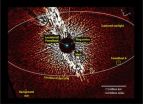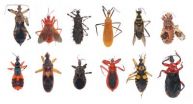(Press-News.org) Universities not only provide the ideal petri dish for cultivating bioscience with commercial potential, but have a moral obligation to do so, given the opportunity to translate public funding into health and jobs, according to a new case study by UCSF researchers.
In an analysis published Oct. 24, 2012 in Science Translational Medicine, researchers at the California Institute for Quantitative Biosciences (QB3) assessed the impact of the institute's efforts over the past eight years in supporting entrepreneurs on the three UC campuses in which it operates: UCSF, UC Berkeley and UC Santa Cruz.
The study found that, by lowering the hurdle even very slightly for scientists to become entrepreneurs, the scientists were able to gain extraordinary traction in translating academic research into public benefit, generating 60 new companies in the first six years and attracting 75 new bioscience entrepreneurs in the last year alone.
"This fundamentally changes the way we think of academic science," said Douglas Crawford, PhD, assistant director of QB3 and senior author on the paper. "There is a distressing paucity of new drugs in the pipeline and a clear need for new economic engines in this country. This is a call to action to address that."
The paper cites the following essential support that universities can provide:
Bioscience-focused incubators
An open network approach that enables any entrepreneur to participate
Competitive seed funding options
Real-world mentoring that gives scientist a clear sense of market needs.
In the first six years since QB3 started supporting entrepreneurs at the UCSF Mission Bay campus, its growing network of incubators helped launch 60 new bioscience companies at UCSF and across the San Francisco Bay at UC Berkeley – at a cost of $1 million per year. Of those, 56 are still in business, and 13 have moved beyond the incubator network or have been purchased by larger companies.
Together, those companies have created more than 280 jobs and attracted more than $230 million in either small business grants or venture capital funding for those companies, which are primarily focused on developing therapeutics, medical devices and research tools. That's a 38-fold return on investment, despite current negative trends in seed-stage investing, in addition to the public benefit of any products those companies generate.
The federal government invests $50 billion per year in academic research, including $23 billion for life sciences from the National Institutes of Health (NIH) alone, according to the paper. Both Baltimore, which is home to universities, and the San Francisco Bay Area receive about $2 billion annually in government research and development funding, yet productivity as measured by high-tech startups was 20-fold higher in the San Francisco area than Baltimore, the analysis found.
"This is clearly not an issue of how much funding is coming to the region. It's an issue of how we think about our social contract," said Regis B. Kelly, PhD, UCSF professor of biochemistry and biophysics, executive director of QB3 and a co-author on the paper. "Most people would say the public good a university offers is in providing research and education, but if we truly want to support the public with the benefits of science, we need to stop seeing economic growth and new medications as an inadvertent byproduct of academic research."
Many U.S. universities, including UCSF, are exploring ways to work with the private sector, with the multiple goals of invigorating research on campus, expediting drug development and ultimately improving the therapies that make it to the market.
That's a relatively new way of thinking, though, and one that often has been met with both skepticism and charges of conflicts of interest by those who believe science should be completely devoid of commercial influences.
"We have a fundamental charge as scientists to make an economic impact and to translate science into public benefit," Crawford said. "That's not a traditional way of thinking of universities, but at a certain point, we need to reassess that traditional thinking and take pride in the fact that a university's public contributions extends beyond its classrooms."
The paper points to the mission statement of the NIH, the nation's largest bioscience funding agency, which specifically includes a goal "to enhance the Nation's economic well-being and ensure a continued high return on the public investment in research."
"So as academic scientists, we are actually paid to protect and improve health, to prevent disease, and to enhance economic well-being," Crawford said. "This is not a sell-out to industry. It's an obligation to society."
Among the programs cited in the paper is a year-old mentoring program known as QB3 Startup in a Box, which connects scientists with external legal, professional and business experts to guide them in starting a new company. So far, the program has helped launch more than 75 virtual companies that are currently applying for grants, establishing business plans and pitching to investors. Seventeen are already operational.
Crawford emphasized that the goal of the analysis is not to assess blame, but to find solutions, and there are many. The authors also hope to generate discussion about which solutions work. The paper can be found online at www.sciencetranslationalmedicine.org.
###
Co-authors include Kenneth D. Harrison, PhD and Neena S. Kadaba, PhD, also with QB3. Authors declare no conflicts of interest.
UCSF is a leading university dedicated to promoting health worldwide through advanced biomedical research, graduate-level education in the life sciences and health professions, and excellence in patient care. Visit www.ucsf.edu.
Follow UCSF
UCSF.edu | Facebook.com/ucsf | Twitter.com/ucsf | YouTube.com/ucsf
Academia should fulfill social contract by supporting bioscience startups, case study says
2012-10-26
ELSE PRESS RELEASES FROM THIS DATE:
Scientists deepen genetic understanding of MS
2012-10-26
Five scientists, including two from Simon Fraser University, have discovered that 30 per cent of our likelihood of developing Multiple Sclerosis (MS) can be explained by 475,806 genetic variants in our genome. Genome-wide Association Studies (GWAS) commonly screen these variants, looking for genetic links to diseases.
Corey Watson, a recent SFU doctoral graduate in biology, his thesis supervisor SFU biologist Felix Breden and three scientists in the United Kingdom have just had their findings published online in Scientific Reports. It's a sub-publication of the journal ...
Sharing space:
2012-10-26
A new University of Michigan study shows that when researchers share a building, and especially a floor, the likelihood of forming new collaborations and obtaining funding increases dramatically.
The findings have wide relevance to corporations, as well.
"Our analyses clearly show that there are benefits to co-location," said Jason Owen-Smith, an associate professor of sociology and organizational studies.
Researchers who occupy the same building are 33 percent more likely to form new collaborations than researchers who occupy different buildings, and scientists who ...
New study brings a doubted exoplanet 'back from the dead'
2012-10-26
A second look at data from NASA's Hubble Space Telescope is reanimating the claim that the nearby star Fomalhaut hosts a massive exoplanet. The study suggests that the planet, named Fomalhaut b, is a rare and possibly unique object that is completely shrouded by dust.
"Although our results seriously challenge the original discovery paper, they do so in a way that actually makes the object's interpretation much cleaner and leaves intact the core conclusion, that Fomalhaut b is indeed a massive planet," said Thayne Currie, an astronomer formerly at NASA's Goddard Space ...
NASA spacecraft sees huge burp at Saturn after large storm
2012-10-26
NASA's Cassini spacecraft has tracked the aftermath of a rare massive storm on Saturn. Data reveal record-setting disturbances in the planet's upper atmosphere long after the visible signs of the storm abated, in addition to an indication the storm was more forceful than scientists previously thought.
Data from Cassini's composite infrared spectrometer (CIRS) instrument revealed the storm's powerful discharge sent the temperature in Saturn's stratosphere soaring 150 degrees Fahrenheit (83 kelvins) above normal. At the same time, researchers at NASA's Goddard Space Flight ...
A clearer picture of how assassin bugs evolved
2012-10-26
RIVERSIDE, Calif. — Assassin bugs, so named because these insects lie in ambush for prey that they attack with speed and precision, are found all over the world. Nearly 140 species of these bugs are blood-sucking; because they can bite humans around the mouth, they are also called kissing bugs. All kissing bugs can spread Chagas disease, a neglected tropical disease that imposes an economic burden on society.
Surprising, then, that scientists' understanding of the evolutionary history of assassin bugs is riddled with difficulty. The data are incomplete. Fossils, which ...
High-risk carotid artery plaque formation is increased in older COPD patients
2012-10-26
Older patients with chronic obstructive pulmonary disease (COPD) are at increased risk for carotid artery plaque formation and for the presence of vulnerable plaques with a lipid core, according to a new study from researchers in the Netherlands.
"We know that COPD is a risk factor for ischemic stroke, and that certain components of carotid artery plaques such as intraplaque hemorrhage and lipid core increase the risk of ischemic events, but plaque composition in patients with COPD has not been examined," said researcher Bruno H.C. Stricker, MD, PhD, professor of pharmaco-epidemiology ...
Integrated diabetes management program provides rapid improvements in patient care
2012-10-26
Ottawa, October 26, 2012 - In Canada alone, almost 2 million people are known to be living with diabetes. And around a million more have the disease but are not aware of that fact, and have not been given the tools they need to control their blood sugar and safeguard their health. The Heart Institute will be presenting the results of an innovative pilot program on October 29, at the Canadian Cardiovascular Congress in Toronto, Canada.
Diabetic patients have a much greater risk of dangerous cardiovascular events, including recurrent heart attacks and development of heart ...
Tips to Help Establish Financial Security After Divorce
2012-10-26
A divorce marks more than just the end of a relationship; it also represents the end of a financial partnership. As a result, it is important to take a step back from the emotional side of the divorce and review the financial side both during and after the divorce proceeding.
Before a divorce is finalized, it is wise to attempt to develop a post-divorce budget. This will help you to determine what assets you need when determining marital property division in the divorce.
After the divorce is complete, take a moment to look over your new expenses and income. Review ...
Franchisee Lawsuit Against Cold Stone Creamery Subject to Arbitration
2012-10-26
A group of Cold Stone Creamery franchisees is suing parent company Cold Stone Creamery Inc. over the failure of the franchisor to disclose information about marketing and gift cards. The franchisee-franchisor suit regarding an alleged lack of transparency was filed in a Florida court.
The National Independent Association of Cold Stone Creamery Franchisees filed suit against Cold Stone Creamery earlier this year asking Cold Stone to disclose the amount of money in a flexible marketing program and the unspent amount in the ice cream chain's gift card program. The NIACCF ...
Non-Disclosure and Non-Compete Agreements Important Tools for Businesses
2012-10-26
Proprietary information is the life blood of businesses and it is as important as ever in today's business world. Businesses can use tools like non-disclosure forms to protect trade secrets from third parties, and tools like non-compete agreements to help ensure that former employees who learned their skills and knowledge from the business do not use confidential business information to benefit competitors.
One way a business can protect its unique information from being used elsewhere is a non-disclosure agreement. A non-disclosure or confidentiality agreement requires ...


